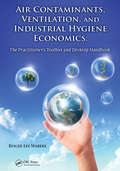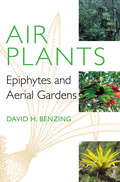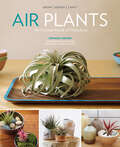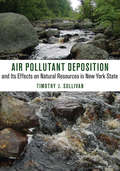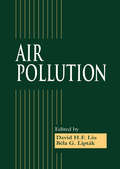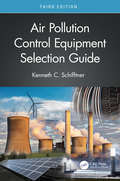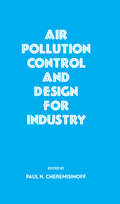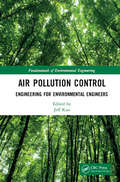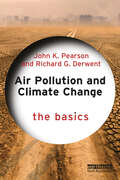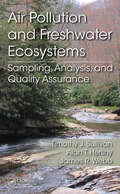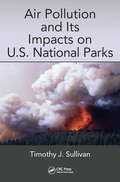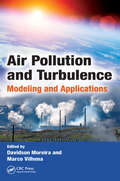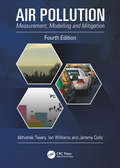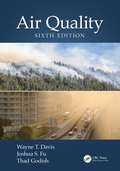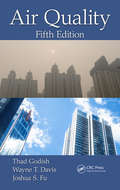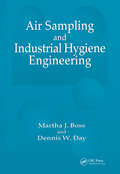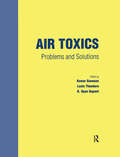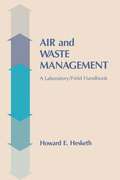- Table View
- List View
Air Contaminants, Ventilation, and Industrial Hygiene Economics: The Practitioner's Toolbox and Desktop Handbook
by Roger Lee WabekeThere is nothing more devastating to baseless opinions than good numbers. Air Contaminants, Ventilation, and Industrial Hygiene Economics: The Practitioner's Toolbox and Desktop Handbook helps you obtain "good numbers" on your quest to squash shabby opinions with sound advice. It details real-world applications of good numbers to foster improvement
Air Plants: Epiphytes and Aerial Gardens
by David H. BenzingOften growing far above the ground, "air plants" (or epiphytes) defy many of our common perceptions about plants. The majority use their roots only for attachment in the crowns of larger, usually woody plants-or to objects such as rocks and buildings-and derive moisture and nutrients from the atmosphere and by collecting falling debris. Only the mistletoes are true parasites. Epiphytes are not anomalies and there are approximately 28,000 species-about 10 percent of the higher or vascular plants-that grow this way. Many popular houseplants, including numerous aroids, bromeliads, ferns, and orchids, rank among the most familiar examples. In Air Plants, David H. Benzing takes a reader on a tour of the many taxonomic groups to which the epiphytes belong and explains in nontechnical language the anatomical and physiological adaptations that allow these plants to conserve water, thrive without the benefit of soil, and engage in unusual relationships with animals such as frogs and ants.Benzing's comprehensive account covers topics including ecology, evolution, photosynthesis and water relations, mineral nutrition, reproduction, and the nature of the forest canopy as habitat for the free-living and parasitic epiphytes. It also pays special attention to important phenomena such as adaptive trade-offs and leaf economics. Drawing on the author's deep experience with epiphytes and the latest scientific research, this book is accessible to readers unfamiliar with technical botany; it features a lavish illustration program, references, a glossary, and tables.
Air Plants: The Curious World of Tillandsias
by Zenaida Sengo Caitlin Atkinson“In this beautiful book, artist Zenaida Sengo has provided inspiration for designing and living with tillandsias.” —Flora GrubbAir Plants, by Zenaida Sengo shows how simple and rewarding it is to grow, craft, and design with these modern beauties. Decorating with air plants is made easy with stunning photographs that showcase ideas for using them mounted on walls, suspended from the ceiling, as living bows and jewelry, as screens, and in unique containers, like leather pouches, dishes, and baskets. Six step-by-step projects include a wood mount, a wall hook, lasso-and-hook wiring, a ceramic-frame garden, and three unique terrariums.
Air Pollutant Deposition and Its Effects on Natural Resources in New York State
by Timothy J. SullivanEcosystem effects from air pollution in the Adirondacks, Catskills, and elsewhere in New York have been substantial. Efforts to characterize and quantify these impacts, and to examine more recent recovery, have focused largely on surface waters, soils, and forests. Lakes, streams, and soils have acidified. Estuaries have become more eutrophic. Nutrient cycles have been disrupted. Mercury has bioaccumulated to toxic levels. Plant species composition has changed. Some surface waters show signs of partial chemical recovery in response to emissions control programs, but available data suggest that soil chemistry may continue to deteriorate under expected future emissions and deposition. Resource managers, policymakers, and scientists now need to know the extent to which current and projected future emissions reductions will lead to ecosystem recovery.In this book, Timothy J. Sullivan provides a comprehensive synthesis of past, current, and potential future conditions regarding atmospheric sulfur, nitrogen oxides, ammonium, and mercury deposition; surface water chemistry; soil chemistry; forests; and aquatic biota in New York, providing much needed information to help set emissions reduction goals, evaluate incremental improvements, conduct cost/benefit analyses, and prioritize research needs. He draws upon a wealth of research conducted over the past thirty years that has categorized, quantified, and advanced understanding of ecosystem processes related to atmospheric deposition of strong acids, nutrients, and mercury and associated ecosystem effects. An important component of this volume is the new interest in the management and mitigation of ecosystem damage from air pollution stress, which builds on the "critical loads" approach pioneered in Europe and now gaining interest in the United States. This book will inform scientists, resource managers, and policy analysts regarding the state of scientific knowledge on these complex topics and their policy relevance and will help to guide public policy assessment work in New York, the Northeast, and nationally.
Air Pollutants in the Context of One Health: Fundamentals, Sources, and Impacts (The Handbook of Environmental Chemistry #134)
by Sylvester Chibueze Izah Matthew Chidozie Ogwu Abbas ShahsavaniThis book reviews air pollutants and their effects on human health, biodiversity, and environmental quality in the context of the One Health framework. Written by experts in the field, the book covers topics such as natural and anthropogenic sources of air pollutants, air pollutants classification based on their chemical composition, physical properties, and origins, and consequences of air pollution on ecosystems, wildlife, and human communities. In this book, readers will find a detailed examination of pollutants, such as particulate matter, volatile organic compounds, and greenhouse gases, and will learn about the mechanisms by which pollutants impact, for instance, the respiratory, cardiovascular, and neurological systems. The book highlights the need for understanding the different pollutants and their One Health effects as a foundation for developing effective regulations, emission controls, cleaner technologies, and promoting lifestyle changes. The book also offers a global perspective on air pollution, and discusses the disproportionate impacts of air pollution on vulnerable populations. In alignment with the United Nations Sustainable Development Goals (SDG), specifically SDG 3 (Good Health and Well-being), SDG 7 (Affordable and Clean Energy), and SDG 11 (Sustainable Cities and Communities), this book takes a focused approach to the One Health implications of various air pollutants and is an important contribution to the global effort to mitigate the impact of air pollution on human health, biodiversity security, and environmental quality. Together with its companion work “Sustainable Strategies for Air Pollution Mitigation”, this book is a valuable resource for students, researchers, policymakers, and anyone seeking a comprehensive perspective on this critical environmental and public health challenge.
Air Pollution
by David H.F. Liu and Béla G. LiptákWhether considered a threat to the health of humans in particular or of the ecosystem in general, the problem of air pollution affects us all. In addition to the 189 chemicals listed in the air toxins category of the 1990 Clean Air Act Amendments, smog, acid rain, ozone depletion, and global warming all arise from air pollution. You can debate the prime causes óacid rain, excessive lumbering or changes in the weather ó but the diminishing rainforest and the spreading desert speak for themselves.Air Pollution addresses the sources and results of these problems, and how they influence the environment. It surveys all aspects of management, including dispersion modeling, emission measurements, air quality and continuous emission monitoring, remote sensing, and stack sampling. In addition, the book explores methods of reduction and control, with particular attention to gaseous emission controls and odor control.This stellar resource addresses the prevention of pollution created by existing technology, and the design of future zero-emissions technology. A useful guide for engineers, students or anyone working for environmental protection, Air Pollution provides a solid foundation and presents a sound environmental philosophy.Béla G. Lipták speaks on Post-Oil Energy Technology on the AT&T Tech Channel.
Air Pollution Control Equipment Selection Guide
by Kenneth C. SchifftnerThis new edition of Air Pollution Control Equipment Selection Guide builds upon the successes of previous editions that developed a detailed discussion on various technologies used for air pollution control. This book covers a wide range of equipment and provides a good overview of the related principles and applications. A particularly valuable feature are the practical examples, not commonly available in other books. Based on the author’s fifty years of experience in applying and operating air pollution control equipment, this book provides easy-to-read information on basic air pollution control technology and is the quintessential resource for the busy engineer and for those who do not have formal training in air pollution control.FEATURES OF THE THIRD EDITION Uniform and consistent applications information for comparing the effectiveness of different technologies. Provides answers to questions about how to reduce operating costs and how to achieve peak performance. Concise descriptions of each equipment with diagnostics and testing suggestions. New chapters on optimization techniques that help readers deal with different types of hardware for better performance and efficacy.
Air Pollution Control Technology Handbook
by Karl B. Schnelle Jr. Russell F. Dunn Mary Ellen TernesA detailed reference for the practicing engineer, Air Pollution Control Technology Handbook, Second Edition focuses on air pollution control systems and outlines the basic process engineering and cost estimation required for its design. Written by seasoned experts in the field, this book offers a fundamental understanding of the factors resulting i
Air Pollution Control and Design for Industry
by PaulN. CheremisinoffPresents current methods for controlling air pollution generated at stationary industrial sources and provides complete coverage of control options, equipment and techniques. The main focus of the book is on practical solutions to air pollution problems.
Air Pollution Control: Fundamentals and Applications (Fundamentals of Environmental Engineering)
by Jeff KuoAir pollution control and air quality engineering are some of the key subjects in any environmental engineering curriculum. This book will cover topics that are fundamental to pollution control engineers and professionals, including air pollution and its management through regulatory approaches, calculating and estimating emissions, and appying con
Air Pollution Control: Traditional Hazardous Pollutants, Revised Edition
by Howard D. HeskethSince the first edition was printed in 1991, there have only been minor changes in air regulations. The opposing "trenches" used by environmental regulation proponents have deepened as each side increases their database. Agencies and environmental groups have backed off a little in issues such as bubble policies and enforcement time tables. This has made it extremely difficult for equipment vendors to anticipate industry requirements. Overall, the current market projections are not very favorable for the new equipment suppliers. In contrast, the service organizations are seeing increasing need for their help in areas such as dispersion modeling, troubleshooting and testing. Existing systems are being improved upon to keep them in operation. There remains a continuous need for up-to-date references and training materials to serve these needs, and it is for this purpose this revised edition is dedicated.
Air Pollution and Climate Change: The Basics (The Basics)
by John K. Pearson Richard DerwentThis book identifies four key forms of air pollution: indoor, urban, regional and global. It discusses how these four types of pollution are manifest in today’s society and examines the scientific and policy challenges that stand in the way of progress. Written in a style that balances scientific underpinnings with accessible language, Pearson and Derwent examine the sources and historical context of air pollutants, before dedicating a chapter to each of the key forms. Armed with these basics, they begin to address the challenges faced by improving indoor, urban and regional air quality, whilst reducing global warming in the years ahead. This leads to a greater understanding of the challenges of global climate change, with new proposals for reducing global warming. However, the authors conclude that it is only when we have a scenario of reforestation combined with reductions in emissions of all greenhouse gases that real progress will be made in the fight against climate change. Then, air pollution will also be consigned to history. With a foreword written by Professor James Lovelock, this book will be of great interest to students and scholars of climate change and environmental policy, as well as air quality professionals working in this important field.
Air Pollution and Freshwater Ecosystems: Sampling, Analysis, and Quality Assurance
by Timothy J Sullivan Alan T. Herlihy James R. WebbA practical book for professionals who rely on water quality data for decision making, this book is based on three decades experience of three highly published water and watershed resource professionals. It focuses on the analysis of air pollution sensitive waters and the consequent effects associated with soil and water acidification, nutrient-
Air Pollution and Its Impacts on U.S. National Parks
by Timothy J. SullivanA variety of air pollutants are emitted into the atmosphere from human-caused and natural emissions sources throughout the United States and elsewhere. These contaminants impact sensitive natural resources in wilderness, including the national parks. The system of national parks in the United States is among our greatest assets. This book provides a compilation and synthesis of current scientific understanding regarding the causes and effects of these pollutants within national park lands. It describes pollutant emissions, deposition, and exposures; it identifies the critical (tipping point) loads of pollutant deposition at which adverse impacts are manifested.
Air Pollution and Turbulence: Modeling and Applications
by Davidson Moreira Marco VilhenaSince its discovery in early 1900, turbulence has been an interesting and complex area of study. Written by international experts, Air Pollution and Turbulence: Modeling and Applications presents advanced techniques for modeling turbulence, with a special focus on air pollution applications, including pollutant dispersion and inverse problems. The
Air Pollution: Health and Environmental Impacts
by Luisa T. Molina Bhola R. Gurjar Chandra S. P. OjhaAir pollution is recognized as one of the leading contributors to the global environmental burden of disease, even in countries with relatively low concentrations of air pollution. Air Pollution: Health and Environmental Impacts examines the effect of this complex problem on human health and the environment in different settings around the world. I
Air Pollution: Measurement, Modelling and Mitigation (4th Edition)
by Ian Williams Abhishek TiwaryThis established textbook offers a one-stop, comprehensive coverage of air pollution, all in an easy-reading and accessible style. The fourth edition, broadly updated and developed throughout, includes a brand-new chapter providing a broader overview to the topic for general reading, and presents fresh materials on air pollution modelling, mitigation and control, tailored to the needs of both amateur and specialist users. Retaining a quantitative perspective, the covered topics include: gaseous and particulate air pollutants, measurement techniques, meteorology and modelling, area sources, mobile sources, indoor air, effects on plants, materials, humans and animals, impact on climate change and ozone profiles and air quality legislations. This edition also includes a final chapter covering a suite of sampling and laboratory practical experiments that can be used for either classroom teachings, or as part of research projects. As with previous editions, the book is aimed to serve as a useful reading resource for upper-level undergraduate and postgraduate courses specialising in air pollution, with dedicated case studies at the end of each chapter, as well as a list of revision questions provided at the end as a complementary section.
Air Pollution: Measurement, Modelling and Mitigation, Third Edition
by Jeremy Colls Abhishek TiwaryA one stop, comprehensive textbook, covering the three essential components of air pollution science. The Third Edition has been updated with the latest developments, especially the inclusion of new information on the role of air pollutants in climate change. The authors give greater coverage to the developing economies around the world where air pollution problems are on the rise. The Third Edition continues to cover a wide range of air quality issues, retaining a quantitative perspective. Topics covered include - gaseous and particulate air pollutants, measurement techniques, meteorology and dispersion modelling, mobile sources, indoor air, effects on plants, materials, humans and animals. Moving away from classical toxic air pollutants, there is a chapter on climate change and another on the depletion of stratospheric ozone. A special feature of this new edition is the inclusion of a fresh chapter on air pollution mitigation by vegetation, mainly its role in maintaining a sustainable urban environment. Recommended for upper-level undergraduate and postgraduate courses specialising in air pollution, both for environmental scientists and engineers. The new material included in the Third Edition extends its use by practitioners in consultancies or local authorities.
Air Quality
by Joshua S. Fu Wayne T. DavisThe sixth edition of a bestseller, Air Quality provides students with a comprehensive overview of air quality, the science that continues to provide a better understanding of atmospheric chemistry and its effects on public health and the environment, and the regulatory and technological management practices employed in achieving air quality goals. Maintaining the practical approach that has made previous editions popular, the chapters have been reorganized, new material has been added, less relevant material has been deleted, and new images have been added, particularly those from Earth satellites. New in the Sixth Edition New graphics, images, and an appended list of unit conversions New problems and questions Presents all-new information on the state of air quality monitoring Provides the latest updates on air quality legislation in the United States Updates the effects of air pollution and CO2 on climate change Examines the effects of the latest changes in energy production and the related emissions and pollutants Offers broadened coverage of air pollutant emissions and air quality in a global context This new edition elucidates the challenges we face in our efforts to protect and enhance the quality of the nation’s air. It also highlights the growing global awareness of air quality issues, climate change, and public health concerns in the developing world. The breadth of coverage, review questions at the end of each chapter, extensive glossary, and list of readings place the tools for understanding into your students’ hands.
Air Quality
by Thad Godish Joshua S. Fu Wayne T. DavisThe fifth edition of a bestseller, Air Quality provides students with a comprehensive overview of air quality, the science that continues to provide a better understanding of atmospheric chemistry and its effects on public health and the environment, and the regulatory and technological management practices employed in achieving air quality goals.
Air Quality Permitting
by R. Leon LeonardThis practical book covers all of the fundamentals for obtaining air quality permits for new sources of air pollutant emissions and Title V operating permits for operating sources. Written for facility environmental managers, consultants, and air quality regulatory staff, Air Quality Permitting provides a thorough discussion on the strategies of successfully permitting a facility.
Air Quality and Livestock Farming (Sustainable Energy Developments)
by Thomas Banhazi Andres Aland Jörg HartungAir quality has a direct influence on health, welfare and production performance of livestock as the high concentrations of noxious gases, dust and airborne microorganisms are likely to reduce production efficiency and the general welfare of farm animals. Long term exposure to particulates in livestock buildings might also affect the respiratory health of farm workers. Dust in animal buildings contains many biologically active substances such as bacteria, fungi, endotoxins and residues of antibiotics (as a result of veterinary treatments) that are suspected to be hazardous to human health. Furthermore, air pollutants emitted from livestock buildings can reduce air, water and soil quality and can potentially undermine the health of nearby residents. Airborne emissions include ammonia, methane, nitrous oxide, particulates like dust and microorganisms. In addition, other potentially harmful substances such as heavy metals, antibiotic residues and components of disinfectants might be also emitted from livestock building that are potentially damaging to ecosystems. In this book, key aspects of agricultural air quality, such as monitoring, managing and reducing airborne pollutants in and around livestock facilities are reviewed. Features: addressing the raising awareness of the importance of optimal health and welfare for lifestock species with contributions from international specialists and researchers providing up-to-date information for professionals involved in modern animal producti This book will be useful for farming professionals, academics, students, policy makers, business leaders, regulatory bodies and agricultural consultants.
Air Sampling and Industrial Hygiene Engineering
by Martha J. Boss Dennis W. DayWe know certain chemicals cause problems in the workplace. The issues now are: Where do they occur in the workplace? How can we best evaluate them? What are the procedures for dealing with them safely? Many books simply define the problem and tell you that you need a program. Air Sampling and Industrial Hygiene gives you a guide to air sampling protocols from start to finish. The book presents sampling technology updated with today's tools - such as microcircuitry and remote sensing. The authors emphasize an interdisciplinary approach to understanding how air monitoring can adequately report current environmental conditions associated with outdoor media, indoor remediation efforts, proximal equipment, interior line monitoring, and the interrelationship of ventilation parameters. In addition to providing the how-tos of sampling, this guide covers the basics of chemical risk assessment, biological assessment, engineering evaluation of mechanical system design criteria, and chemical or process engineering hazard assessments. It presents the information using text, text outlines, graphics, and pictures - including cross sections of instrumentation and side bars to elaborate on complex concepts.Faulty readings caused by poor sampling techniques can be very costly. This book provides the how-tos for making design engineering and on-site decisions as to instrumentation selection and scheduled usage. Air Sampling and Industrial Hygiene Engineering will allow you to complete the sampling process systematically and correctly from initial suspicions to the use of obtained results.
Air Toxics: Problems and Solutions
by Kumar GanesanThis timely new workbook is the result of a year-long effort by a group of university professors who first met at Montana Tech during the summer of 1994 for a college faculty workshop. The workshop was funded by the National Science Foundation's support for those faculty developing courses in the newly emerging field of air toxics. Part I of the book contains over 100 problems dealing with a variety of topics in this area. Part II provides detailed solutions. The problems and solutions provided will become a useful resource for the training of engineers and scientists who are or soon will be working in the field.
Air and Waste Management: A Laboratory and Field Handbook
by Howard D. HeskethThis manual will serve a useful function in training and giving experience to environmental scientists at all levels. Included in this manual are explanatory materials, exercises and experiments. These are intended as training guides. The users of this manual will find it possible to use simple equipment and naturally occurring events to construct some of the needed equipment but may also find it necessary to use commercially available equipment with some of the procedures.
